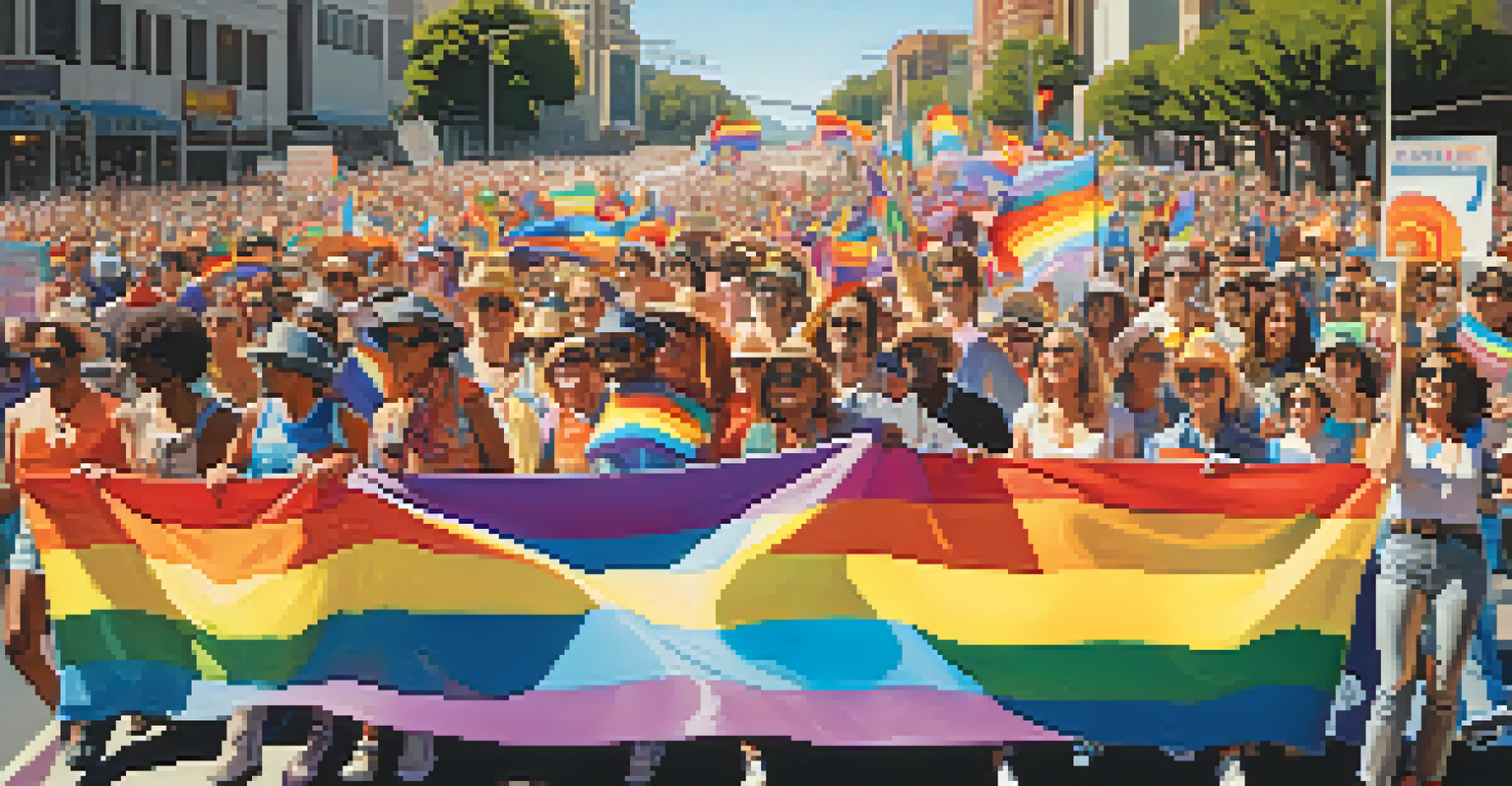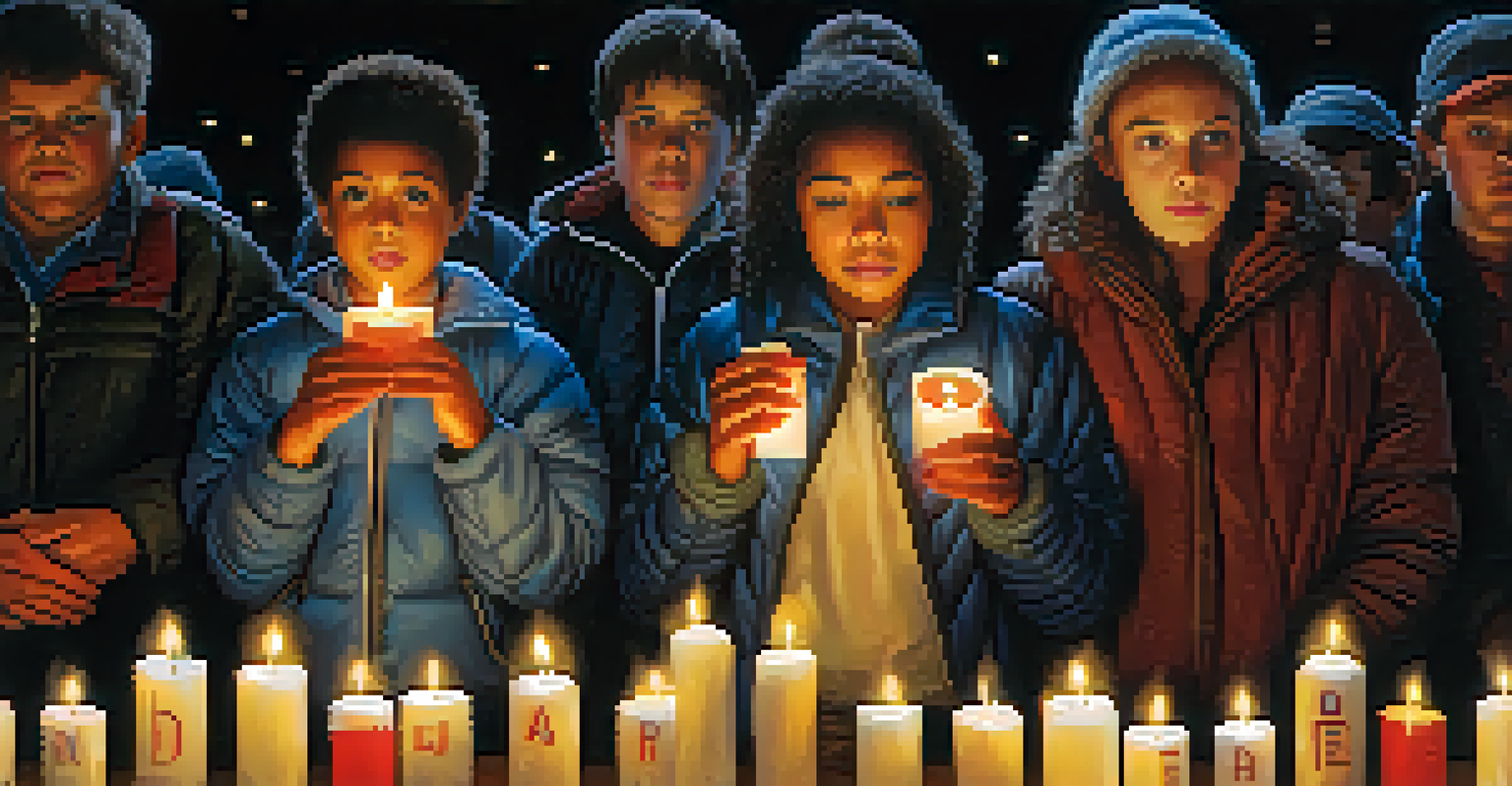The Origins of LGBTQ+ Rights in California: A Historical Overview

The Early Struggles: Pre-1940s LGBTQ+ Existence in California
Before the 1940s, LGBTQ+ individuals in California faced severe discrimination and societal stigma. Many lived in secrecy, fearing persecution from both the law and their communities. This oppressive environment often forced them to create hidden networks for support, laying the groundwork for future activism.
The only way to deal with the future is to function efficiently in the now.
Despite the challenges, pockets of LGBTQ+ culture began to emerge, particularly in urban areas like San Francisco. Speakeasies and underground clubs offered safe spaces where individuals could express themselves freely, albeit discreetly. These social hubs became critical for fostering community and solidarity among LGBTQ+ folks.
The groundwork for activism was slowly being laid in these years, as early organizations started to form, advocating for basic rights and visibility. While not widely recognized at the time, these efforts were essential in setting the stage for the significant changes that would follow.
World War II: A Catalyst for Change in LGBTQ+ Visibility
World War II marked a significant turning point for LGBTQ+ individuals, as many were enlisted and stationed far from their homes. This exposure to new environments allowed them to meet others like themselves, fostering a sense of community that was previously difficult to attain. The war also brought about a sense of urgency regarding the need for rights and recognition.

Upon returning home, many veterans found themselves unwilling to return to their previous lives of secrecy. This newfound confidence and visibility led to increased activism, as returning soldiers began to advocate for their rights more openly. The formation of groups like the Mattachine Society in 1950 was a direct response to this desire for change.
LGBTQ+ Activism Emerges Pre-1940s
Before the 1940s, LGBTQ+ individuals in California formed hidden networks to support one another amid severe discrimination and stigma.
The war's aftermath prompted discussions about LGBTQ+ rights and acceptance on a larger scale, paving the way for organized movements. The experiences of these veterans highlighted the need for social reform, laying the foundation for the activism that would gain momentum in the following decades.
The 1950s: The Birth of LGBTQ+ Activism in California
The 1950s saw the emergence of significant LGBTQ+ organizations, notably the Mattachine Society and the Daughters of Bilitis. These groups were pioneers in advocating for the rights of homosexual individuals, focusing on issues like employment discrimination and legal recognition. Their efforts represented a shift from merely seeking acceptance to demanding equality.
We are not what we were, but we are not yet what we will be.
In this decade, public events like protests and rallies began to take shape, raising awareness about the struggles faced by LGBTQ+ people. These gatherings were often met with hostility, yet they showcased the determination of activists who were ready to fight for their rights. They brought attention to the need for legal reforms and societal change.
As the decade progressed, media coverage of LGBTQ+ issues started to increase, albeit often sensationalized. This exposure helped to humanize the community, gradually shifting public perception and opening doors for more conversations about equality and justice.
The Stonewall Effect: California's Response to a Turning Point
The Stonewall Riots in 1969 served as a catalyst for LGBTQ+ rights movements across the United States, including California. This pivotal event galvanized activists, leading to a surge in visibility and advocacy. In California, the riots inspired a wave of protests and celebrations, such as the first Pride events.
Activists in California were determined to channel the energy from Stonewall into meaningful change. They organized marches, rallies, and educational campaigns to raise awareness about LGBTQ+ issues. This period marked a transition from a focus on legal rights to a broader push for societal acceptance and recognition.
Stonewall Sparks California Activism
The Stonewall Riots of 1969 energized LGBTQ+ activists in California, leading to increased visibility and organized advocacy for rights.
The aftermath of Stonewall created a sense of urgency among activists in California, resulting in the formation of new organizations and coalitions. These groups worked tirelessly to advocate for policy changes, laying the groundwork for future legislative victories.
The 1970s: California's Fight for Legal Rights and Recognition
The 1970s were a defining decade for LGBTQ+ rights in California, marked by significant legal battles and advocacy efforts. Activists pushed for anti-discrimination laws, health care access, and the decriminalization of homosexuality. These efforts culminated in the landmark 1975 decision by the California Supreme Court that ruled against employment discrimination based on sexual orientation.
The decade also saw the rise of the Gay Liberation movement, which emphasized pride, visibility, and the celebration of LGBTQ+ identities. Events like the San Francisco Pride Parade became symbols of resistance and solidarity, drawing thousands of participants and allies. This newfound visibility was crucial for fostering acceptance in broader society.
However, the fight was far from over. The emergence of the AIDS crisis in the early 1980s presented new challenges, pushing activists to navigate both the stigma associated with the disease and the urgent need for healthcare and support services.
The 1980s: Responding to the AIDS Crisis and Continuing Advocacy
The AIDS crisis of the 1980s profoundly affected the LGBTQ+ community, leading to increased activism and advocacy. Many activists shifted their focus towards healthcare access, funding for research, and combating the stigma surrounding the disease. Organizations like ACT UP emerged, using direct action to demand government accountability and support.
This period was marked by sorrow, loss, and resilience, as countless individuals fought against an epidemic that disproportionately affected the LGBTQ+ community. Memorials and marches became powerful symbols of remembrance and a call for action, highlighting the urgent need for change.
Milestones in LGBTQ+ Rights Achieved
The 1990s brought significant legal victories for LGBTQ+ individuals in California, including advancements toward marriage equality and anti-discrimination measures.
Despite the challenges, the community's response to the crisis fostered solidarity and unity. This collective resilience laid the groundwork for future advocacy efforts, emphasizing the importance of health equity and social justice for all marginalized communities.
The 1990s and Beyond: Achieving Milestones in LGBTQ+ Rights
The 1990s marked a turning point in California's LGBTQ+ rights movement, with significant milestones achieved in legal recognition and representation. The fight for marriage equality gained momentum, leading to the establishment of various domestic partnership laws. These laws were crucial steps toward broader recognition of LGBTQ+ relationships.
Throughout the late 1990s and early 2000s, activists worked tirelessly to combat initiatives that sought to undermine LGBTQ+ rights, such as Proposition 22 in 2000. The community's resilience in the face of adversity demonstrated their commitment to achieving equality, leading to the eventual legalization of same-sex marriage in California in 2008.

The journey towards LGBTQ+ rights in California is ongoing, with continued efforts to address issues like discrimination, healthcare access, and transgender rights. Each victory is a testament to the strength of the community and the importance of advocacy in the pursuit of justice and equality for all.